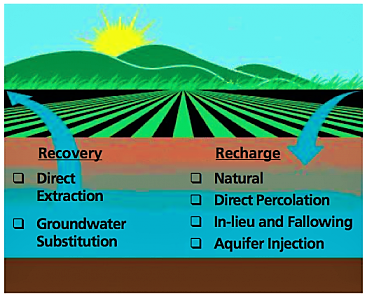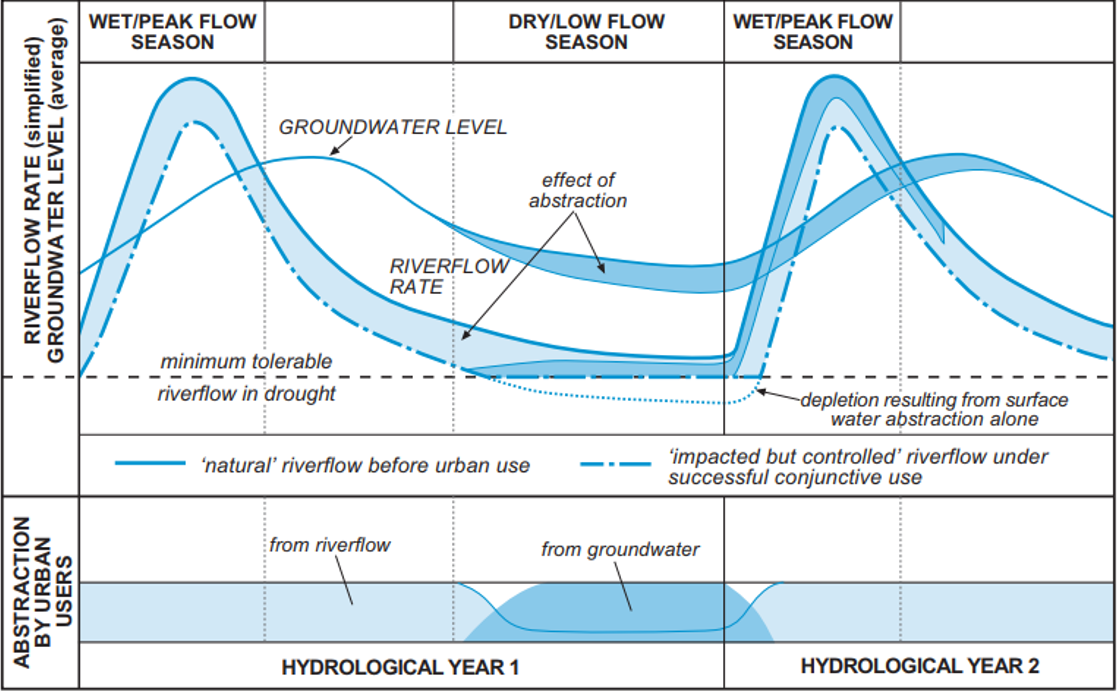Executive Summary
Conjunctive use of water relates to the combined use of ground and surface water. Due to the augmented water source, higher water reliability can be achieved. Conjunctive use therefore functions as a buffer for periods of water scarcity. The idea of this management approach is to use surface water when the water table is high and change to groundwater when the water table is low. This technique might be especially important as a buffer function for mitigating impacts of climate change, such as increased heat and drought (FOSTER et al. 2010).
| In | Out |
|---|---|
Freshwater |
Introduction
Even though there is no consistent definition of conjunctive use of water, it is most commonly referred to as the combined use of ground and surface water (FOSTER et al. 2010). The natural hydrologic connection between groundwater and surface water is used in order to improve water reliability (see also the water cycle). This practice can become particularly important for mitigating problems related to climate change, such as increased drought or overexploitation and decreases in groundwater availability (see also water resources assessment and water pollution) (DUDLEY & FULTON 2005).
Basic design principles
Two main usage phases of conjunctive use are differentiated:
- Recharge: when the water table is high, the use of surface water is to be maximised. The recharge of groundwater can be enhanced artificially by surface water recharge and subsurface water recharge.
- Recovery: During dry season, water is drawn from groundwater resources (for possible measures to draw groundwater, see groundwater sources).


It is important to keep recharge and recovery in balance (see also water balance estimation). However, as there are usually several users (e.g. farmers) relying on the same water source, individual use may lead to overexploitation of groundwater. This is a widespread problem, because conjunctive use often occurs unplanned and by default. To enhance the benefits of this practice, better coordination between the users is needed, which is part of conjunctive water management discussed below (WORLD BANK 2006).
Conjunctive water management
Adapted from DUDLEY & FULTON (2005)
Conjunctive water management is an improved form of conjunctive use. Additional to the combined use of surface water and groundwater, components of groundwater management tools, such as water balance estimation and water resources assessment, are added. In comparison to conjunctive use, conjunctive water management helps to better manage water use between different parties, leading to well-prepared recharge and recovery phases and therefore to a lower probability of harming groundwater sources.
Today, conjunctive water management is less frequently implemented than conjunctive use, because of lacking institutions or coordination mechanisms (see also building an institutional framework) (WORLD BANK 2006).
Health aspects
If usage is done unplanned, groundwater can be exploited or salinity of groundwater may increase, leading to diminished agricultural productivity. Increased salinity may also be a threat to the security of drinking water supplies (FOSTER et al. 2010).
Operation and maintenance
Conjunctive use of water is often done by default and therefore without special knowledge. To optimise the effectiveness of conjunctive use, system managers should be defined and well trained (see also developing human resources). Management of conjunctive use is best done at the local level where the special needs and conditions are known and the interested actors can be involved. Also, the potential for conjunctive use varies with differing hydrogeological settings, including such factors as average rainfall and geomorphological position. For further information on variations of the dynamics and constraints of conjunctive use (see FOSTER et al. 2010).
Achieving well-managed conjunctive use can be impeded by institutional constraints, economic considerations or the political climate (see also creating policies and a legal framework and building an institutional framework). It is therefore necessary to consider these factors during the implementation process. Participatory monitoring and evaluation can help to enhance the needed learning process and coordination within the community. On-going monitoring is recommended in order to constantly improve conjunctive use.
At a glance
| Working principle | Shared use of groundwater and surface water resources. |
| Capacity/adequacy | Conjunctive use is often part of an overall water resources management based on water balance estimations. It may be used for both urban and rural areas. Its effectiveness differs due to different hydrogeological settings. |
| Performance | High performance, which may have long-term impacts on water availability and quality. |
| Self-help compatibility | Special knowledge is needed. Otherwise, groundwater sources may be exploited. |
| O&M | On-going monitoring and adaptations are needed. |
| Reliability | Only reliable if monitoring and coordination is done well. |
| Main strength | Improves sustainability of water sources. |
| Main weakness | High complexity. |
The potential for conjunctive use varies with differing hydrogeological settings, including such factors as average rainfall and geomorphological position. The implementation choice therefore needs to be adapted to the prevalent conditions (FOSTER et al. 2010). It is best implemented on the local level, as it is easier to identify the special needs and circumstances of the community and monitoring on local level is more easily applied.
Conjunctive Use of Groundwater and Surface Water
Conjunctive Water Management. Economic Tools for Evaluating Alternative Policy and Management Options
A paper describing the role and key components of hydro-economic models for effective conjunctive water management. Three such models, the steady state lumped parameter model, the dynamic lumped parameter model and the distributed parameter model are described more precisely.
HAFI, A. (2006): Conjunctive Water Management. Economic Tools for Evaluating Alternative Policy and Management Options. Canberra: Australian Bureau of Agricultural and Resource Economic (ABARE) URL [Accessed: 19.09.2012] PDFConjunctive Use Issues. Optimizing Resources and Minimizing Adverse Effects
This paper discusses six different water diversion possibilities applied in Colorado, USA. Insights are given on how the concept of conjunctive use can add to the reliability of a more standardised water rights plan and may also increase the yield.
JEHN, L. J. (n.y): Conjunctive Use Issues. Optimizing Resources and Minimizing Adverse Effects. Denver, CO: Jehn Water Consultants, Inc. URL [Accessed: 19.09.2012] PDFConjunctive use and management of groundwater and surface water
This paper explores the reasons underpinning the apparent poor approach to full integration in the management and use of both water sources, and the absence of more coordinated planning. This paper is intended to provide insight into these barriers to adoption and hence provide a new focus on an old paradigm; a focus intended to make progress with the objective of improved water management and water use efficiency and so support longer term outcomes in the form of improved food security in critical parts of the world.
FAO GEF IAH IHP Worldbank (2012): Conjunctive use and management of groundwater and surface water. Australia: Sinclair Knight Merz URL [Accessed: 28.03.2013] PDFConjunctive Water Use in an African River Basin. A Case Study in poor Planning
A case study of poor water related projects done in the River Rokel (Seli) basin in Sierra Leone, West Africa. This paper describes the problems that were faced and also places recommendations for future planning.
AKIWUMI, F. A. (1997): Conjunctive Water Use in an African River Basin. A Case Study in poor Planning. In: Sustainability of Water Resources under Increasing Uncertainty: Volume 240 URL [Accessed: 19.09.2012] PDFConjunctive Use of Canal and Groundwater in Punjab, Pakistan. Management and Policy Options
This study identifies trends in conjunctive use of canal and groundwater in the Punjab area of Pakistan and its implications for sustainability of agricultural performance. A main problem of the use of surface (canal) water arises due impact of farmer of the head end on the water supply for farmers on the tail end of the canal.
MURRAY-RUST, D. H. ; VELDE, E. J. van der (1994): Conjunctive Use of Canal and Groundwater in Punjab, Pakistan. Management and Policy Options. In: Irrigation and Drainage Systems : Volume 8 , 201-231. URL [Accessed: 19.09.2012] PDFSustaining Surface and Groundwater Resources. Proceedings of the International Workshop on Conjunctive Water Management for Sustainable Irrigated Agriculture in South Asia, April 2002
Groundwater is the largest source of irrigation in South and Southeast Asia and China, its use for cities growing rapidly, leading to higher salinity of groundwater resources. Conjunctive water management is seen as a potential solution to ensure environmentally sustainable and financial viable irrigation agriculture. This paper delivers an overview on this thematic.
QURESHI, A. S. ; BHATTI, A. ; JEHANGIR, W. A. (2002): Sustaining Surface and Groundwater Resources. Proceedings of the International Workshop on Conjunctive Water Management for Sustainable Irrigated Agriculture in South Asia, April 2002. Lahore, Pakistan: International Water Management Institute (IWMI) URL [Accessed: 19.09.2012] PDFConjunctive Use of Surface and Ground Water for Improving Water Productivity in Coastal Area of Orissa
This study on conjunctive use was carried out in an Eastern part of India, which has plenty of water but poor utilisation compared to other parts of India.
SINGANDHUPE, R. B. SETHI R. R. CHAKRAVARTY, H. MOHANTY, R. K. KUMAR, A. (2012): Conjunctive Use of Surface and Ground Water for Improving Water Productivity in Coastal Area of Orissa. (= Proceedings of: India Water Week 2012 - Water, Energy and Food Security: Call for Solutions, April 2012 ). New Delhi: India Water Week URL [Accessed: 19.09.2012] PDF
